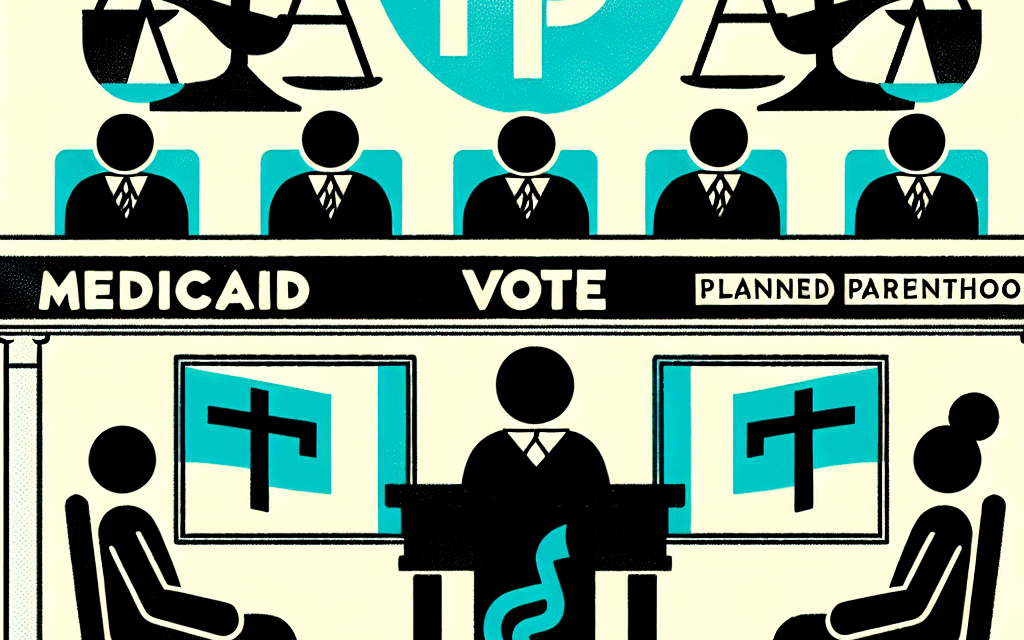Supreme Court Permits States to Reduce Medicaid Funding for Planned Parenthood
The recent decision by the Supreme Court to allow states to reduce Medicaid funding for Planned Parenthood has sparked a significant debate across the United States. This ruling not only impacts the funding of reproductive health services but also raises questions about women’s health, state rights, and the role of federal funding in healthcare. In this article, we will explore the implications of this decision, the historical context of Medicaid funding, the impact on women’s health services, the political landscape surrounding the issue, and the potential future of reproductive health funding in America.
Historical Context of Medicaid and Planned Parenthood
Medicaid, established in 1965, is a federal-state program designed to provide healthcare coverage to low-income individuals and families. Over the years, it has become a critical source of funding for various health services, including reproductive health care provided by organizations like Planned Parenthood. Understanding the historical context of Medicaid and its relationship with Planned Parenthood is essential to grasp the implications of the Supreme Court’s ruling.
Planned Parenthood was founded in 1916 and has since evolved into one of the largest providers of reproductive health services in the United States. The organization offers a range of services, including contraception, cancer screenings, and sexually transmitted infection (STI) testing. A significant portion of its funding comes from Medicaid, which allows low-income individuals to access these essential services.
In the 1970s, the federal government began to recognize the importance of family planning services, leading to the inclusion of these services in Medicaid. This was a pivotal moment for organizations like Planned Parenthood, as it allowed them to expand their reach and provide care to millions of women who might otherwise lack access to reproductive health services.
However, the relationship between Medicaid and Planned Parenthood has been contentious, particularly in recent years. Various states have attempted to defund Planned Parenthood, arguing that taxpayer money should not support an organization that provides abortions. This has led to numerous legal battles, culminating in the Supreme Court’s recent decision, which has significant implications for the future of reproductive health funding.
The Supreme Court’s Decision: Implications and Reactions
The Supreme Court’s ruling to permit states to reduce Medicaid funding for Planned Parenthood has been met with a mix of support and opposition. Proponents of the decision argue that states should have the authority to determine how their Medicaid funds are allocated, while opponents contend that this ruling undermines women’s access to essential health services.
One of the primary implications of this decision is the potential reduction in funding for Planned Parenthood in states that choose to defund the organization. This could lead to a significant decrease in the availability of reproductive health services, particularly in rural and underserved areas where Planned Parenthood clinics often serve as the only source of care.
For example, in Texas, a state that has previously attempted to defund Planned Parenthood, studies have shown that the closure of clinics led to increased rates of unintended pregnancies and decreased access to contraceptive services. Similar outcomes could be expected in other states that follow suit after the Supreme Court’s ruling.
Reactions to the decision have been polarized. Supporters of the ruling, including many conservative lawmakers, argue that it empowers states to make decisions that reflect their values and priorities. They contend that taxpayer money should not be used to fund organizations that provide abortions, even if those organizations also offer other essential health services.
On the other hand, opponents, including women’s health advocates and many healthcare professionals, argue that the ruling disproportionately affects low-income women who rely on Medicaid for access to reproductive health services. They warn that defunding Planned Parenthood could lead to a public health crisis, as many women may be unable to access necessary care.
Impact on Women’s Health Services
The reduction of Medicaid funding for Planned Parenthood has far-reaching implications for women’s health services across the country. Planned Parenthood plays a crucial role in providing a wide range of healthcare services, and any reduction in funding could have dire consequences for women’s health.
One of the most significant impacts of reduced funding is the potential decrease in access to contraceptive services. Planned Parenthood is a leading provider of birth control, offering a variety of options to meet the needs of women. According to the Guttmacher Institute, nearly 40% of women who obtain contraceptive services from publicly funded clinics do so at Planned Parenthood. If funding is cut, many women may find it challenging to access affordable birth control, leading to an increase in unintended pregnancies.
In addition to contraceptive services, Planned Parenthood provides essential screenings for breast and cervical cancer, STI testing, and general health check-ups. A study published in the American Journal of Public Health found that women who receive care from Planned Parenthood are more likely to receive timely screenings and preventive care compared to those who do not. The loss of funding could result in fewer women receiving these critical services, ultimately leading to poorer health outcomes.
Moreover, the impact of reduced funding is likely to be felt most acutely in rural and underserved communities. Many Planned Parenthood clinics are located in areas where healthcare options are limited, and they often serve as the only source of reproductive health care for low-income women. The closure of these clinics could exacerbate existing health disparities, leaving vulnerable populations without access to necessary care.
Furthermore, the psychological impact of losing access to reproductive health services cannot be overlooked. Women who rely on Planned Parenthood for their healthcare may experience increased anxiety and stress if they are unable to access the services they need. This can have a cascading effect on their overall well-being and quality of life.
The Political Landscape Surrounding Medicaid Funding
The political landscape surrounding Medicaid funding for Planned Parenthood is complex and deeply divided. The issue of reproductive health has long been a contentious topic in American politics, with strong opinions on both sides. Understanding the political dynamics at play is crucial to grasping the implications of the Supreme Court’s decision.
On one side of the debate are conservative lawmakers and organizations that advocate for defunding Planned Parenthood. They argue that taxpayer money should not support an organization that provides abortions, even if those services are only a small part of what Planned Parenthood offers. This perspective is rooted in a broader anti-abortion agenda that seeks to limit access to abortion services across the country.
In contrast, many progressive lawmakers and women’s health advocates argue that access to reproductive health services is a fundamental right. They contend that defunding Planned Parenthood disproportionately affects low-income women and undermines public health efforts. This perspective is supported by numerous studies that demonstrate the importance of access to reproductive health services in reducing unintended pregnancies and improving overall health outcomes.
The political landscape is further complicated by the role of federal funding in state Medicaid programs. While Medicaid is a joint federal-state program, states have significant discretion in how they allocate funds. This has led to a patchwork of policies across the country, with some states actively working to defund Planned Parenthood while others continue to support its funding.
In recent years, several states have passed laws aimed at defunding Planned Parenthood, often citing the organization’s provision of abortion services as justification. These laws have faced legal challenges, with opponents arguing that they violate federal Medicaid law, which requires states to provide beneficiaries with a choice of qualified healthcare providers. The Supreme Court’s recent ruling has now set a precedent that may embolden more states to pursue similar defunding efforts.
As the political landscape continues to evolve, it is essential for advocates on both sides of the issue to engage in constructive dialogue. Finding common ground on reproductive health services may be challenging, but it is crucial for ensuring that all women have access to the care they need.
The Future of Reproductive Health Funding in America
The Supreme Court’s decision to permit states to reduce Medicaid funding for Planned Parenthood raises important questions about the future of reproductive health funding in America. As states grapple with the implications of this ruling, it is essential to consider the potential pathways forward for reproductive health services.
One possible outcome is an increase in state-level efforts to defund Planned Parenthood and similar organizations. As mentioned earlier, the Supreme Court’s ruling may embolden more states to pursue legislation aimed at cutting funding for organizations that provide abortions. This could lead to a significant reduction in access to reproductive health services for low-income women across the country.
However, there is also the potential for a counter-movement advocating for the protection and expansion of reproductive health funding. Many women’s health advocates are mobilizing to push back against defunding efforts, emphasizing the importance of access to comprehensive healthcare services. This could lead to increased public awareness and support for reproductive health issues, ultimately influencing policymakers to prioritize funding for organizations like Planned Parenthood.
Additionally, the future of reproductive health funding may be influenced by changes in federal policy. The Biden administration has expressed support for expanding access to reproductive health services and has taken steps to reverse some of the previous administration’s policies aimed at defunding organizations like Planned Parenthood. This shift in federal policy could provide a lifeline for states that wish to maintain funding for reproductive health services.
Moreover, innovative funding models may emerge as states and organizations seek to navigate the changing landscape of reproductive health funding. For example, some states may explore public-private partnerships or alternative funding sources to ensure that women continue to have access to essential health services. These models could provide a way to sustain funding for reproductive health services even in the face of political challenges.
Ultimately, the future of reproductive health funding in America will depend on a combination of state-level actions, federal policy changes, and grassroots advocacy efforts. As the landscape continues to evolve, it is crucial for advocates, policymakers, and the public to remain engaged in the conversation surrounding reproductive health and access to care.
Conclusion
The Supreme Court’s decision to permit states to reduce Medicaid funding for Planned Parenthood marks a significant turning point in the ongoing debate over reproductive health services in America. This ruling has far-reaching implications for women’s health, access to care, and the political landscape surrounding reproductive rights.
As we have explored in this article, the historical context of Medicaid and Planned Parenthood reveals a complex relationship that has evolved over decades. The potential reduction in funding for Planned Parenthood raises serious concerns about access to essential health services for low-income women, particularly in underserved communities.
The political dynamics surrounding this issue are deeply divided, with strong opinions on both sides. As states navigate the implications of the Supreme Court’s ruling, it is essential for advocates and policymakers to engage in constructive dialogue to ensure that all women have access to the care they need.
Looking ahead, the future of reproductive health funding in America remains uncertain. While there are potential pathways for both defunding and protecting reproductive health services, it is crucial for advocates and the public to remain vigilant and engaged in the conversation. The health and well-being of millions of women depend on it.





